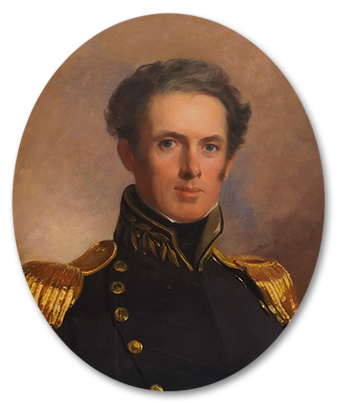Ship's Crew

John Gwinn
Rank(s): Captain
Dates of Service: 10/9/1848 - 9/4/1849
Birth Date: 6/11/1791
Death Date: 9/4/1849
Marylander John Gwinn was born on June 11, 1791. He was warranted a midshipman in 1809 at age 18. His first service was on a schooner on Chesapeake Bay. He was later ordered to Boston as a part of the commissioning crew of the sloop-of-war Frolic. Unfortunately for Gwinn and his shipmates, the British captured Frolic on her first War of 1812 cruise, and the crew remained prisoners until the war’s end. Gwinn was promoted to lieutenant in 1816. In the following decade, he made two deployments to the Mediterranean and a voyage to northern Europe in three different ships. Between 1828 and 1848, he spent a total of 10 years at the Philadelphia Navy Yard, three years on leave, and five “awaiting orders.” The remaining two years he divided between commanding the sloop-of-war Vandalia and the frigate Potomac. He was promoted to Captain in 1842.
An ailing Captain Gwinn placed Constitution back in commission early in October 1848. The ship sailed for the Mediterranean in December and made directly for Algiers, where she took aboard Consul Daniel Smith McCauley and his family for transfer to Egypt. As they entered the port of Alexandria, his wife, Frances Ann McCauley, gave birth to a son named Constitution Stewart McCauley. From there, the ship returned west to Italian waters to join the rest of the squadron in protecting American interests in revolution-torn Italy. Despite an injunction against any action that might indicate American bias, on August 1, 1849, Gwinn hosted a visit by Pope Pius IX and the fugitive King of Two Sicilies, Ferdinand II, while anchored off Gaeta, Italy. Because a commissioned warship is considered national territory, this is considered the first visit of a Roman Catholic Pope to America. Shortly thereafter, Gwinn’s health deteriorated to the point where he was bed-ridden and suffered periods of delirium and mania. He died of chronic gastritis on September 4, 1849 while the ship lay at Palermo, Sicily.
Gwinn was buried with full military honors at Palermo, but the proceedings were disrupted by disaffected members of the crew who got roaring drunk along the route to the cemetery. As a result, at least 32 men were flogged in the days to follow. He was reinterred at Arlington National Cemetery in 1931.